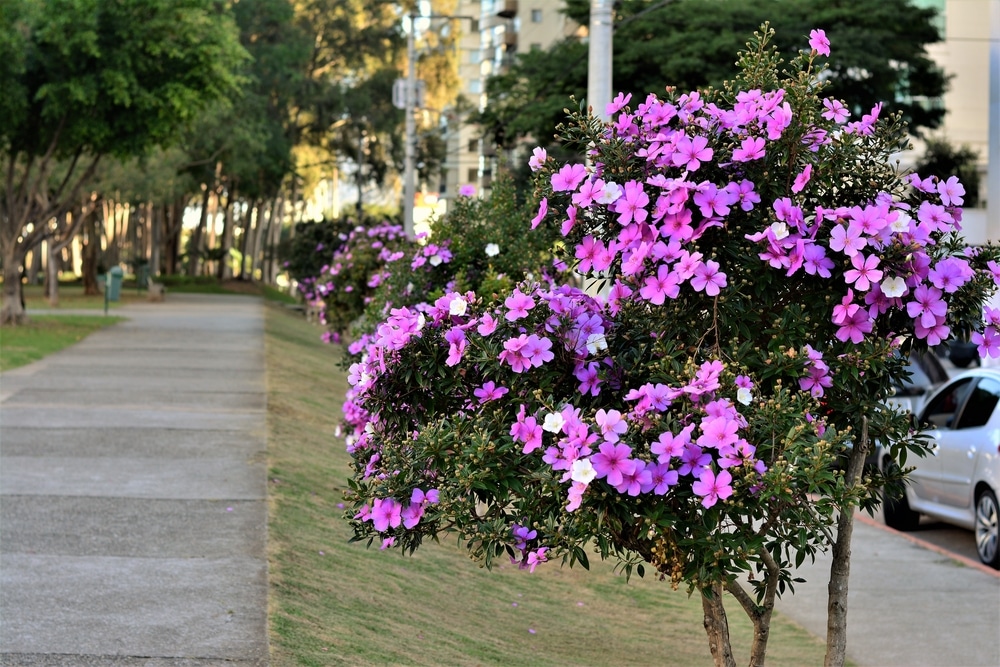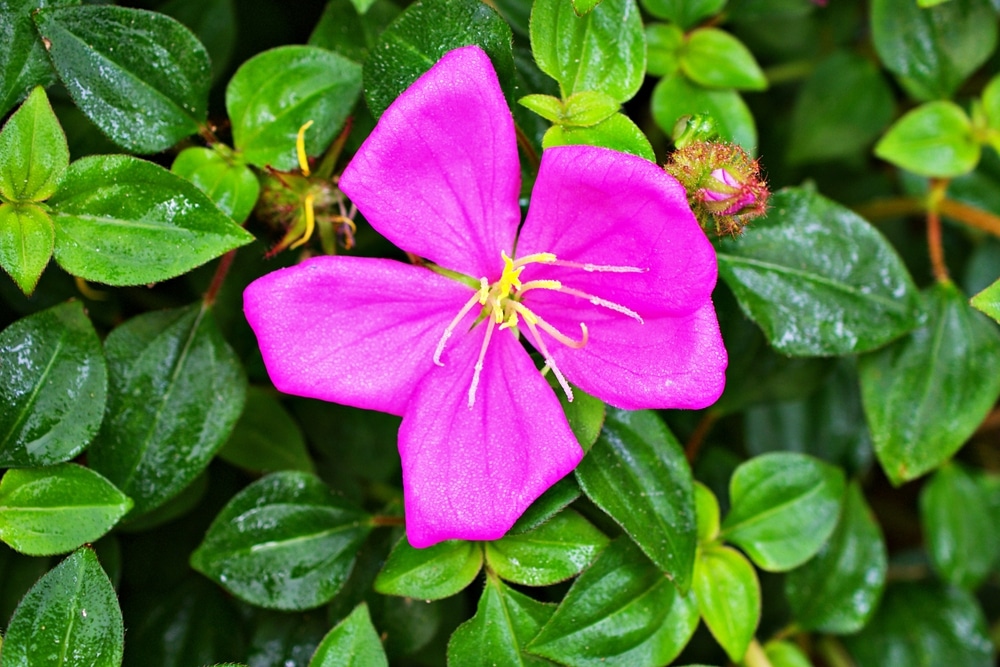It’s commonly thought of and grown as a houseplant, or as an outdoor shrub. When left alone, however, tibouchina will grow into a small, lush tree that produces breathtaking, royal purple blooms.
In this guide, we’ll go over everything you need to know about caring for your tibouchina tree, including tips on watering, sunlight, fertilizer, and more.
Here’s a quick summary of the most important facts about the tibouchina tree:
| Botanical Name | Tibouchina urvilleana |
| Common Name | Tibouchina Tree, Princess Flower, Glory Bush |
| Plant Type | Perennial in zones 9-11, Perennial that dies back to the ground in zone 8 |
| Flower Color | Vibrant purple, 3-5in. wide. |
| Size When Mature | 2-3ft. tall indoors, 6-8ft. tall outdoors (can reach 15ft) |
| Bloom Time | Year-round |
| Sun Requirements | Full Sun (Partial shade in uncomfortably hot regions) |
| USDA Hardiness Zones | 9-11 |
| Soil PH Range | 5.5-6.5 |
| Soil Type | Slightly acidic, well-draining |
| Water Needs | Medium |
| Native Area | Brazil |
What you Need to Know About Tibouchina
Tibouchina, also known as glory bush or princess flower, is a tree that belongs to the Melastomataceae and is native to Brazil.
Scientifically known as Tibouchina urvilleana, It’s a tropical broadleaf evergreen that produces gorgeous, purple blooms. And while this tree is typically used as a border or foundation shrub on a majority of the lawns in the US, it can be used as an ornamental tree if left to become large.
The plant can reach up to 15 feet tall, even though most people keep it at 6-8ft when it comes to height. Given that it has a sprawling habit when growing, it’s recommended that you go for a plant that has been trained to a single trunk if you’re buying.
The tibouchina tree has silvery velvet leaves that are about 2-6 inches long and have a width of 1-1.5 inches. In the ideal climate, the eye-catching, purple flowers with a width of 3-5 inches can keep blooming throughout the year. To encourage such a blooming habit, it’s recommended that you deadhead the plant.
This plant also produces small, brown fruits that have a capsule appearance and are less than 1/2 inch in length. And while Tibouchina spp. is listed as a species that is non-toxic to humans, dogs, and cats, it still has the potential to be a choking hazard for kids.
How to Care for Tibouchina Trees
Here’s everything you need to know about growing and caring for a thriving tibouchina tree:
– Light
Tibouchina trees enjoy being in sunny spots, but they can also tolerate partial sun. In truth, it’s necessary to shade your plant if the weather is too hot or if you live in a region with sweltering days.
It’s recommended that you allow your tibouchina tree to receive direct sunlight for a minimum of five hours every day.
– Water
Tibouchina trees are quite drought-tolerant, which means that they can still survive even when they are not watered frequently. However, for optimal growth, you should water your plant at least once a week.
Make sure that the soil is preferably damp but not soggy. A good rule of thumb is to stick to no more than an inch of water every week.
– Soil
This plant prefers to grow in moistened, well-drained soil that is rich in organic matter. It’s especially important to ensure that the soil is not soggy at all, as this can encourage root rot.
The tibouchina tree appreciates being grown in slightly acidic soil with a pH of 5.5 to 6.5. If your soil is not acidic enough, you can always rectify that with the help of peat moss or by using an acid fertilizer.
– Fertilizer
Tibouchina trees are not particularly heavy feeders, which means that they should be okay with being fed every fall, summer, and spring. The type of fertilizer that you use should be one that favors acid-loving plants such as azalea or Rhodos.
You can also apply a little bit of manure, and use a mulch layer to help your plant retain moisture.
– Temperature Requirements
Tibouchinas thrive best when grown in temperatures that are approximately 70 degrees Fahrenheit. This tree is not a huge fan of very scalding hot or frigid weather. That’s why it thrives best in USDA hardiness zones 9-11.
Since the tibouchina tree is a tropical plant, that means that it especially dislikes frost. That being the case, if you’re in a cold region, it’s a good idea to have your tibouchina as a houseplant.
That way, you can always bring it indoors when the temperatures start to drop too much for comfort.
– Common Diseases and Pests
Tibouchina trees are not very susceptible to pests and diseases. However, that being said, they can be affected by scale, aphids, nematodes, geranium budworm, and mealybugs.
The good news is that you can manage these pests by introducing beneficial insects like ladybugs. For the more serious infestations, spraying your plant with horticultural oil or insecticidal soap should do the trick.
As for diseases, one of the most common that affects tibouchinas is mushroom root-rot. This one typically occurs when the plant is in soggy soil. To avoid this issue, it’s important to make sure that the soil is well-drained and that you are not overwatering it.
Tibouchina Tree Propagation
There are two reliable ways that you can go about propagating tibouchina trees. You can either choose to propagate them via seed or by stem cuttings.
– Propagating by stem cuttings
This is often considered to be the easier of the two methods of propagation. All you need to do is take a four-inch cutting just below a leaf node. To encourage root growth, it’s a good idea to dip the cutting in some rooting hormone.
After that, plant the cutting in a pot filled with seed-starting potting mix. Make sure that the cutting is placed in such a way that the leaf node is buried. Water the soil lightly and then cover the pot using a plastic dome or bag.
You will need to place the pot in an area that has bright, indirect sunlight and keep the controlled environment moist. Maintain a temperature of 65 to 75 degrees Fahrenheit.
After a few weeks, you should see new growth. Once that happens, you can remove the plastic dome or bag and allow the cutting to acclimate to its new environment.
In about 10 weeks and a maximum of 12 weeks, the new plant should be sufficiently rooted to allow safe transplanting in the final location.
– Propagating by seed
This method is a little bit more challenging than propagating by stem cuttings. To start, you need to collect the seeds from a tibouchina tree, then place them in a paper bag and transfer them to the fridge until it’s spring.
When spring arrives, you need to plant the seeds by covering them with approximately 2 inches of seed-starting mix. Make sure that the mix is moist and that the seeds are sufficiently spaced (1 inch between every two seeds is sufficient).
After that, cover the grow tray using a plastic bag and place it in an area that has bright, indirect sunlight. Maintain the same temperature of 65 to 75 degrees Fahrenheit. Once your seedlings attain a height of about 2 inches, you can transplant them into individual pots.
Related article: Purple Indoor Plants


